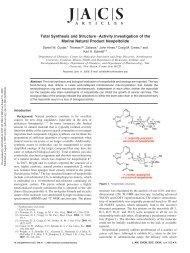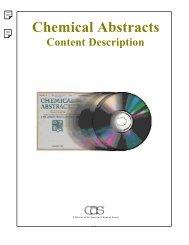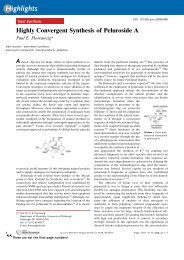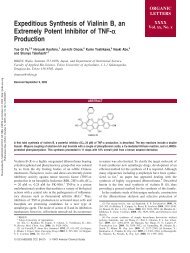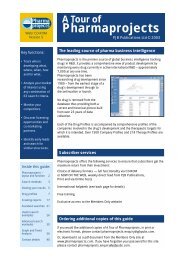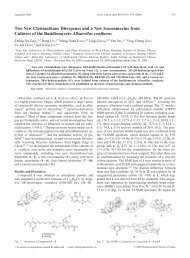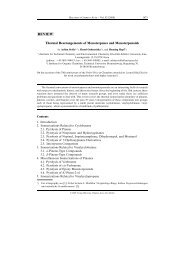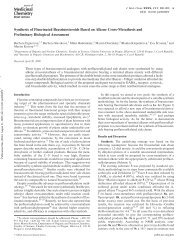Accepted Manuscript
Accepted Manuscript
Accepted Manuscript
You also want an ePaper? Increase the reach of your titles
YUMPU automatically turns print PDFs into web optimized ePapers that Google loves.
<strong>Accepted</strong> <strong>Manuscript</strong><br />
Isolation of the protein tyrosine phosphatase 1B inhibitory metabolite from the<br />
marine-derived fungus Cosmospora sp. SF-5060<br />
Changon Seo, Jae Hak Sohn, Hyuncheol Oh, Bo Yeon Kim, Jong Seog Ahn<br />
PII: S0960-894X(09)01282-7<br />
DOI: 10.1016/j.bmcl.2009.09.025<br />
Reference: BMCL 14848<br />
To appear in: Bioorganic & Medicinal Chemistry Letters<br />
Received Date: 21 July 2009<br />
Revised Date: 3 September 2009<br />
<strong>Accepted</strong> Date: 8 September 2009<br />
Please cite this article as: Seo, C., Sohn, J.H., Oh, H., Kim, B.Y., Ahn, J.S., Isolation of the protein tyrosine<br />
phosphatase 1B inhibitory metabolite from the marine-derived fungus Cosmospora sp. SF-5060, Bioorganic &<br />
Medicinal Chemistry Letters (2009), doi: 10.1016/j.bmcl.2009.09.025<br />
This is a PDF file of an unedited manuscript that has been accepted for publication. As a service to our customers<br />
we are providing this early version of the manuscript. The manuscript will undergo copyediting, typesetting, and<br />
review of the resulting proof before it is published in its final form. Please note that during the production process<br />
errors may be discovered which could affect the content, and all legal disclaimers that apply to the journal pertain.
ACCEPTED MANUSCRIPT<br />
Ms. No.: BMCL-D-09-01243<br />
Revised<br />
Isolation of the protein tyrosine phosphatase 1B inhibitory metabolite<br />
from the marine-derived fungus Cosmospora sp. SF-5060<br />
Changon Seo a , Jae Hak Sohn a , Hyuncheol Oh a,* , Bo Yeon Kim b , Jong Seog Ahn b,*<br />
a<br />
College of Medical and Life Sciences, Silla University, San 1-1 Gwaebeop-dong,<br />
Sasang-gu, Busan 617-736, Republic of Korea,<br />
b<br />
Korea Research Institute of Bioscience and Biotechnology (KRIBB), 52 Eoun-dong,<br />
Yuseong-gu, Daejeon 305-333, Republic of Korea<br />
* Corresponding authors. Tel: +82 51 999 5026; fax: +82 51 999 5458 (H. Oh); tel.:<br />
+82 42 860 4312; fax: +82 42 860 4595 (J. S. Ahn).<br />
E-mail addresses: hoh@silla.ac.kr (H. Oh); jsahn@kribb.re.kr (J. S. Ahn).
ACCEPTED MANUSCRIPT<br />
Abstract⎯In the course of bioassay-guided study on the EtOAc extract of a culture<br />
broth of the marine-derived fungus Cosmospora sp. SF-5060, aquastatin A (1) was<br />
isolated as a protein tyrosine phosphatase 1B (PTP1B) inhibitory component produced<br />
by the fungus. The compound was isolated by various chromatographic methods, and<br />
the structure was determined mainly by analysis of NMR spectroscopic data.<br />
Compound 1 exhibited potent inhibitory activity against PTP1B with IC50 value of 0.19<br />
μM, and the kinetic analyses of PTP1B inhibition by compound 1 suggested that the<br />
compound is inhibiting PTP1B activity in a competitive manner. Aquastatin A (1) also<br />
showed modest but selective inhibitory activity toward PTP1B over other protein<br />
tyrosine phosphatases, such as TCPTP, SHP-2, LAR, and CD45. In addition, the result<br />
of hydrolyzing aquastatin A (1) suggested that the dihydroxypentadecyl benzoic acid<br />
moiety in the molecule is responsible for the inhibitory activity.<br />
Keywords: Marine-derived fungus; Cosmospora sp.; Protein tyrosine phosphatase 1B<br />
(PTP1B); Fungal metabolite; Competitive inhibitor<br />
2
ACCEPTED MANUSCRIPT<br />
Marine microorganisms have been recognized as a rich source of structurally novel and<br />
pharmacologically active secondary metabolites. 1,2 Particularly, fungi from marine<br />
environment have shown to produce diverse secondary metabolites which are more or<br />
less similar to those produced by terrestrial fungi. 3,4 As a part of our ongoing studies<br />
on PTP1B inhibitors from marine microorganisms collected from Korea, a fungal<br />
isolate Cosmospora sp. SF-5060 was selected for further investigation on the basis of its<br />
potent inhibitory effect against PTP1B.<br />
Protein tyrosine phosphatases (PTPs) constitute a large family of enzymes, crucial<br />
modulators of tyrosine phosphorylation-dependent cellular events such as growth,<br />
proliferation and differentiation, metabolism, immune response, cell-cell adhesion, and<br />
cell-matrix contacts. 5-7 Among them, protein tyrosine phosphatase 1B (PTP1B), an<br />
intracellular non-receptor type PTP, is considered as a well-validated target for drug<br />
development. The negative regulation of insulin- and leptin-receptor mediated<br />
signaling pathways by PTP1B has been demonstrated by a number of biochemical and<br />
genetic studies. 8-10 Several independent studies have shown that PTP1B-knockout<br />
mice display increased insulin sensitivity, improved glycemic control, and resistant to<br />
diet-induced obesity. 10,11 Accordingly, inhibition of PTP1B is predicted to be an<br />
3
ACCEPTED MANUSCRIPT<br />
excellent, novel therapy to target type 2 diabetes and obesity. Given the compelling<br />
biochemical and genetic evidences linking PTP1B to several human diseases, a number<br />
of efforts have been conducted to develop PTP1B inhibitors. 12,13 However, the<br />
development of small-molecule PTP1B-based drug candidates possessing target<br />
selectivity and bioavailability remains an important challenge. 14<br />
The marine-derived fungus Cosmospora sp. SF-5060 was isolated from an inter-tidal<br />
sediment collected at Gejae Island (April, 2007), and characterized based on analysis of<br />
the ribosomal RNA (rRNA) sequences. Cosmospora sp. SF-5060 was cultivated in<br />
liquid media at 25 o C for 14 days. The filtered culture broth was extracted with EtOAc,<br />
and the resulting organic extract was subjected to C18 functionalized silica gel flash<br />
column chromatography, eluting with a stepwise gradient consisting of MeOH in H2O<br />
(20% to 100% MeOH with 20% increment for each step; 400 mL each). The fraction<br />
eluted at 100% MeOH was then subjected to semi-preparative reversed-phase HPLC to<br />
yield 1.<br />
The structure of 1 was inferred to be a family of the glycosylated depside base on<br />
analysis of the 1 H and 13 C NMR data. In the NMR spectra of 1, the signals<br />
4
ACCEPTED MANUSCRIPT<br />
corresponding to two sets of meta-coupled aromatic protons, twelve aromatic carbons,<br />
and two ester carbonyl carbons suggested the presence of depside-type moiety in the<br />
molecule. In addition, the presence of sugar moiety in the molecule was evident by the<br />
observation of the signals corresponding to a number of oxymethines, an oxymethylene,<br />
and an anomeric methine in the NMR spectra. Eventually, the planar structure of 1<br />
was determined to be aquastatin A by analysis of the 1D and 2D NMR and MS data,<br />
along with in comparison with literature values. 15 However, the absolute configuration<br />
of the β-galactopyranoside aquastatin A was not previously assigned. Therefore,<br />
compound 1 was subjected to acid hydrolysis with 6 N HCl, and the liberated sugar was<br />
identified as D-galactose by TLC analysis and comparison of its specific rotation with<br />
those of authentic samples.<br />
As shown in Table 1, compounds 1 strongly inhibited the hydrolysis of the p-<br />
nitrophenyl-phosphate (pNPP) catalyzed by PTP1B in a dose-dependent manner with<br />
IC50 values of 0.19 μM. The characteristics of the inhibition of PTP1B by compound 1<br />
were then analyzed in detail. PTP1B was incubated with increasing concentrations of<br />
compound 1 and full velocity curves were determined (Figure 1). Non-linear<br />
regression analysis showed that the data best fit a competitive model of inhibition, and<br />
5
ACCEPTED MANUSCRIPT<br />
re-plotting of the data as Lineweaver-Burk transformations confirmed this result,<br />
displaying the characteristic intersecting line pattern for competitive inhibition with a Ki<br />
value of 0.10 μM. Therefore, it was shown that aquastatin A (1) binds to the active site<br />
within PTP1B. Next, compound 1 was converted to the corresponding methyl ester<br />
(compound 2) to evaluate the significance of the carboxylic acid group for potency in<br />
PTP1B inhibition. As shown in Table 1, the IC50 value of compound 2 was<br />
significantly lower than that of compound 1. This observation was consistent with the<br />
previous results; that is the carboxylic acid group plays a major role in the inhibition<br />
mechanism. 16,17<br />
Aquastatin A (1) belongs to the orcinol p-depsides family, and only a few of the orcinol<br />
p-depsides conjugated with sugars have been found in nature. 18 Chemically, they<br />
consist of 2,4-dihydroxy-6-alkylbenzoic acid joined by sugars and another 2,4-<br />
dihydroxy-6-alkylbenzoic acid through two potentially labile bonds to hydrolysis (i.e.,<br />
ester and glycoside bonds). Therefore, a couple of hydrolyzing studies on compound 1<br />
were conducted to check if all these three structural units are required for the inhibitory<br />
mechanism. When compound 1 was subjected to enzymatic hydrolysis with β-<br />
galactosidase, the aglycone moiety of compound 1 was obtained, and the structure was<br />
6
ACCEPTED MANUSCRIPT<br />
identified by analysis of its MS and 1 H NMR data. The resulting hydrolysis product 3<br />
was then evaluated for its PTP1B inhibitory effect, and the observed IC50 value (= 0.22<br />
μM) suggested that the galactose moiety in compound 1 does not play any role in the<br />
inhibition mechanism. Another hydrolysis product 4 was obtained from the basic<br />
hydrolysis condition (1 N NaOH), and the structure was identified by analysis of its MS<br />
and 1 H NMR data. Compound 4 also strongly inhibited the hydrolysis of the pNPP<br />
catalyzed by PTP1B in a dose-dependent manner with IC50 values of 0.59 μM. On the<br />
other hand, the other basic hydrolysis product, 2,4-dihydroxy-6-methylbenzoic acid,<br />
showed only 45% inhibition of PTP1B activity at the 178 μM level. Taken these<br />
observations together, it was suggested that 2,4-dihydroxy-6-pentadecylbenzoic acid is a<br />
critical pharmacophore of aquastatin A (1) in the inhibition of PTP1B activity. 2,4-<br />
Dihydroxy-6-pentadecylbenzoic acid, named corticiolic acid, has been reported as a<br />
constituent of several fungal species, 19 but no biological activity of the compound has<br />
been reported.<br />
In the development of PTP1B inhibitors from natural products or synthetic counter parts,<br />
selective inhibition of PTP1B over other PTPs is one of the biggest issues. Therefore,<br />
the specific inhibitory activities of compound 1 toward a small panel of PTPs including<br />
7
ACCEPTED MANUSCRIPT<br />
cytosolic PTPs, T-cell protein tyrosine phosphatase (TCPTP) and src homology<br />
phosphatase-2 (SHP2), and receptor-like PTP, leukocyte antigen-related phosphatase<br />
(LAR), and CD45 were evaluated. As shown in Table 2, compound 1 displayed<br />
significant selectivity for PTP1B over SHP-2, LAR, and CD45 tyrosine phosphatase<br />
(CD45), but only ~ 2.5-fold over TCPTP. It has been reported that PTP1B and TCPTP<br />
share a high degree of homology within the catalytic active site cleft, imposing a major<br />
problem in finding selective inhibitors for PTP1B.<br />
As noted previously, most of reported PTP1B inhibitors suffer from drawbacks, such as<br />
lack of selectivity and bioavailability. One reason for this is that most of these<br />
compounds were developed to target the positively charged active site of PTP1B, thus<br />
leading to low cell permeability. 14 Second, most PTPs are known to share a highly<br />
conserved catalytic domain that can be broadly inhibited by nonspecific inhibitors. 13<br />
Therefore, the development of novel PTP1B inhibitors with improved target-specificity<br />
and bioavailability is still necessary. In this study, aquastatin A (1) was identified as<br />
competitive inhibitor of PTP1B, and the hydrolyzing studies on the compound led to the<br />
identification of dihydroxypentadecyl benzoic acid as a key pharmacophore.<br />
Aquastatin A (1) showed modest but selective inhibitory activity for PTP1B over other<br />
8
ACCEPTED MANUSCRIPT<br />
PTPs such as TCPTP, SHP-2, LAR and CD45. In addition, the pentadecyl moiety in<br />
the molecule could aid in its ability to diffuse into target cells to inhibit intracellular<br />
PTPs. Therefore, aquastatin A (1) and/or the essential structural feature identified in<br />
this study could be viewed as potential lead compounds for the treatment of diabetes<br />
and obesity. Further optimization of the structures with aiming their selective potency<br />
and efficacy in vivo would be beneficial.<br />
Acknowledgments<br />
This research was supported in part by the grants from Global Partnership<br />
Program (No. M60602000001-06E0200-00100) of Korea Foundation for International<br />
Cooperation of Science & Technology (KICOS) through the grant provided by the<br />
Korean Ministry of Education, Science & Technology (MEST), and KRIBB Research<br />
Initiation Program. We gratefully acknowledge S.-Y. Kim for her technical support of<br />
this project.<br />
Supplementary data<br />
9
version, at<br />
References<br />
ACCEPTED MANUSCRIPT<br />
Supplementary data associated with this article can be found, in the online<br />
1. Proksch, P.; Edrada, R. A.; Ebel, R. Appl. Microbial. Biotechnol. 2002, 59,<br />
125-134.<br />
2. Fenical, W.; Jensen, P. R. Nat. Chem. Biol. 2006, 2, 666-673.<br />
3. Bugni, T. S.; Ireland, C. M. Nat. Prod. Rep. 2004, 21, 143-163.<br />
4. Faulkner, D. J. Nat. Prod. Rep. 2000, 19, 1-48.<br />
5. Tonks, N. K. Nat. Rev. Mol. Cell Biol. 2006, 7, 833-846.<br />
6. Fisher, E. H.; Charbonneau, H.; Tonks, N. K. Science 1991, 253, 401-406.<br />
7. Hunter, T. Cell 1995, 80, 225-236.<br />
8. Bialy, L.; Waldmann, H. Angew. Chem. Int. Ed. 2005, 44, 3814-3839.<br />
9. Koren, S. Best Pract. Res. Clin. Endocrinol. Metab. 2007, 21, 621-640.<br />
10. Elchebly, M.; Payette, P.; Michaliszyn, E.; Cromlish, W.; Collins, S.; Loy, A.<br />
L.; Normandin, D.; Cheng, A.; Himms-Hagen, J.; Chan, C. C.; Ramachandran,<br />
10
ACCEPTED MANUSCRIPT<br />
C.; Gresser, M. J.; Tremblay, M. L.; Kennedy, B. P. Science 1999, 283, 1544-<br />
1548.<br />
11. Klaman, L. D.; Boss, O.; Peroni, O. D.; Kim, J. K.; Martino, J. L.;<br />
Zabolotny, J. M.; Moghal, N.; Lubkin, M.; Kim, Y. B.; Sharpe, A. H.; Stricker-<br />
Krongrad, A.; Shulman, G. I.; Neel, B. G.; Kahn, B. B. Mol. Cell. Biol. 2000,<br />
20, 5479-5489.<br />
12. Zhang, S.; Zhang, Z.-Y. Drug Discov. Today 2007, 12, 373-381.<br />
13. Bialy, L.; Waldmann, H. Angew. Chem. Int. Ed. 2005, 44, 3814-3839.<br />
14. Liu, S.; Zeng, L.-F.; Wu, L.; Yu, X.; Xue, T.; Gunawan, A. M.; Long, Y.-Q.;<br />
Zhang, Z.-Y. J. Am. Chem. Soc. 2008, 130, 17075-17084.<br />
15. Hamano, K.; Kinoshita-Okami, M.; Minagawa, K.; Haruyama, H.; Kinoshita,<br />
T.; Hosoya, T.; Furuya, K.; Kinoshita, K.; Tabata, K.; Hemmi, A.; Tanzawa, K.<br />
J. Antibiot. 1993, 46, 1648-1657.<br />
16. Zhang, Y.-N.; Zhang, W.; Hong D.; Shen, Q.; Li, J.-Y.; Li, J.; Hu, L.-H.<br />
Bioorg. Med. Chem. 2008, 16, 8697-8705.<br />
11
ACCEPTED MANUSCRIPT<br />
17. Na, M.; Oh, W. K.; Kim, Y. H.; Cai, X. F.; Kim, S.; Kim, B. Y.; Ahn, J. S.<br />
Bioorg. Med. Chem. Lett. 2006, 16, 3061-3064.<br />
18. Wang, P.; Zhang, Z.; Yu, B. J. Org. Chem. 2005, 70, 8884-8889.<br />
19. Sontag, B.; Dasenbrock, J.; Arnold, N.; Steglich, W. Eur. J. Org. Chem. 1999,<br />
1051-1055.<br />
12
OH<br />
HO<br />
HO<br />
6''<br />
3''<br />
O<br />
1''<br />
OH<br />
3<br />
O 1<br />
5<br />
8<br />
1 R = H<br />
2 R = CH 3<br />
ACCEPTED MANUSCRIPT<br />
OH<br />
OH<br />
3'<br />
O<br />
O<br />
7<br />
O<br />
5'<br />
1' 7'<br />
OR<br />
8'<br />
OH<br />
HO<br />
HO<br />
6''<br />
3''<br />
O<br />
1''<br />
OH<br />
4<br />
13<br />
22<br />
OH<br />
3<br />
7<br />
O 1<br />
5<br />
8<br />
OH<br />
O<br />
3<br />
HO 1<br />
5<br />
8<br />
OH<br />
OH<br />
3'<br />
O<br />
O<br />
7<br />
O<br />
5'<br />
1' 7'<br />
OH<br />
8'<br />
3<br />
22<br />
22
(a)<br />
(b)<br />
Rate (mA min -1 )<br />
15<br />
10<br />
5<br />
0<br />
1/v<br />
900<br />
800<br />
700<br />
600<br />
500<br />
400<br />
300<br />
200<br />
100<br />
ACCEPTED MANUSCRIPT<br />
0.00 0.25 0.50 0.75 1.00 1.25<br />
pNPP (mmol -1 )<br />
-1 0 1 2 3 4 5<br />
1/[pNPP], mM -1<br />
Figure 1. Substrate titration studies using the small substrate pNPP revealed that<br />
compound 1 is a classical competitive inhibitor that inhibits substrate binding (constant<br />
Km), but not substrate catalysis (Vmax). (a) Velocity measurements performed with<br />
PTP1B in the presence of increasing concentrations of compound 1. (b) The<br />
Lineweaver-Burk transformations of the data from (a). Concentrations (μM) of 1 are<br />
indicated in the figure. Data are expressed as mean initial velocity for n = 3 replicates<br />
at each substrate concentration.<br />
14<br />
no compound<br />
0.075 μM<br />
0.12μM<br />
0.16μM<br />
no compound<br />
0.075 μM<br />
0.12 μM<br />
0.16 μM
ACCEPTED MANUSCRIPT<br />
Table 1. PTP1B inhibitory activity of compounds 1-4<br />
Compound PTP1B inhibitory activity<br />
(IC50 = μM)<br />
1 0.19<br />
2 17<br />
3 0.22<br />
4 0.59<br />
Ursolic acid a<br />
2.5<br />
a positive control<br />
15
ACCEPTED MANUSCRIPT<br />
Table 2. Selectivity of compound 1 against a panel of PTPs<br />
PTPs IC50 (= μM)<br />
PTP1B 0.19<br />
TCPTP 0.51<br />
SHP2 > 44<br />
LAR > 44<br />
CD45 > 44<br />
16
Graphical Abstract<br />
ACCEPTED MANUSCRIPT<br />
Isolation of the protein tyrosine phosphatase 1B<br />
inhibitory metabolite from the marine-derived<br />
fungus Cosmospora sp. SF-5060<br />
Changon Seo, Jae-Hak Sohn, Hyuncheol Oh * , Bo Yeon<br />
Kim, Jong Seog Ahn *<br />
Bioassay-guided investigation on the EtOAc extract of cultures of the marine-derived fungus Cosmospora sp. SF-<br />
5060 afforded a potent tyrosine phosphatase 1B (PTP1B) inhibitory metabolite, aquastatin A.<br />
17<br />
OH<br />
HO<br />
HO<br />
O<br />
O<br />
OH<br />
OH<br />
OH O<br />
O<br />
OH<br />
O



